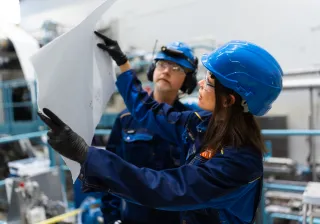Scalable and flexible wireless networks are needed to automate and digitalise industries. VTT ran simulations that confirm the potency of the high-density ETSI DECT-2020 NR (New Radio) network technology promoted by Wirepas.
Wirepas is an international technology company focused on IoT connectivity software development. Wirepas offers a development environment that ensures a reliable flow of data between devices and backend.
Key facts
Performance and scalability of high-density network technology proven with advanced simulations
Results pave the way for the global expansion of the technology
Insufficient networks are a bottleneck for digitalisation
Most industries are currently automating their production. The goal is to have industry 4.0 factories and highly automated buildings, and this requires seamless interaction throughout the whole ecosystem.
Wirepas has been involved in creating a new, 5G-compatible DECT-2020 NR standard that enables machine-type communications for millions of wirelessly connected devices as well as it is capable to support ultra reliable low latency communication.
DECT-2020 NR will provide a very competitive European solution for large-scale digitalisation. The networks can be deployed easily and are well suited for local operation and private networks, including mass-scale or ultra-reliable low-latency communication.
To validate the network technology Wirepas had to showcase how it operates in very high densities. The ITU-R IMT-2020 requirements for massive machine-type communications are strict, which is why DECT-2020 NR had to undergo thorough test simulations. Wirepas selected VTT to conduct an independent review and analysis of the technology.
Heavy network simulations require advanced engineering skills
The biggest challenges in the project were modelling the DECT-2020 NR standard accurately and making the simulation of millions of wireless nodes fast enough. This required careful simulator development work. VTT allocated resources to the optimization and improvement of the simulator until it was possible to run the required massive-scale simulations.
“We used the NS-3 simulation tool for this project. We developed a simulator where the simulation scenario could be split into several stages in order to minimise run time and computer memory consumption, which were both extremely high. We then ran various parallel simulations with high-performance computers. The scenarios were heavy: the largest one, where we analysed four million user nodes in two hours, took only 24 hours in real time,” says Mika Lasanen, Senior Scientist and Project Manager at VTT.
The simulations validated that DECT-2020 NR meets and even exceeds the IMT-2020 requirements, which demand a million user nodes per square kilometre and the transmission of one packet in two hours per device.
Wirepas’ Principal System Engineer Juho Pirskanen explains that the simulations also produced other findings: “The extremely detailed simulations suggested that the network technology works well in various user node densities and that nodes has low power consumption and good coverage properties.”
DECT-2020 NR has the potential to go global
Independent technology analyses are vital in validating and increasing awareness around the DECT-2020 NR standard, which was released less than a year ago. The simulations provided the IoT sector with unprecedented data, which Wirepas can use to promote and license the technology.
DECT-2020 NR-compliant devices co-operate efficiently and extend network coverage. This removes a big digitalisation bottleneck for industries that require high-density or ultra-reliable networks, such as logistics, industry 4.0 and smart buildings.
“We have now received solid proof that supports DECT-2020 NR in becoming widely used globally,” says Jussi Numminen, Director, Head of radio strategy and IPR
from Wirepas.
For VTT, the project with Wirepas provided a possibility to apply their strong background of wireless system and network simulations to the new network technology. VTT now has proven simulation methods for wireless scenarios with millions of radio devices.
More network collaborations planned for the future
Wirepas has previously collaborated with VTT in similar radio research R&D&I projects.
We have worked over the past years together with VTT in several national and international research projects were VTT with their expertise in radio research has provided high quality results.
The collaboration between VTT and Wirepas is about to continue. In the next phase, Wirepas is planning on analysing local industry network deployment scenarios.
VTT is looking forward to continuing the successful co-operation: “We offer both practical pre-commercial performance evaluations and advanced commercial simulations for demanding industrial use cases. This should keep the collaboration with Wirepas active and versatile,” states Tuomas Korpela, Solution Sales Lead at VTT.






